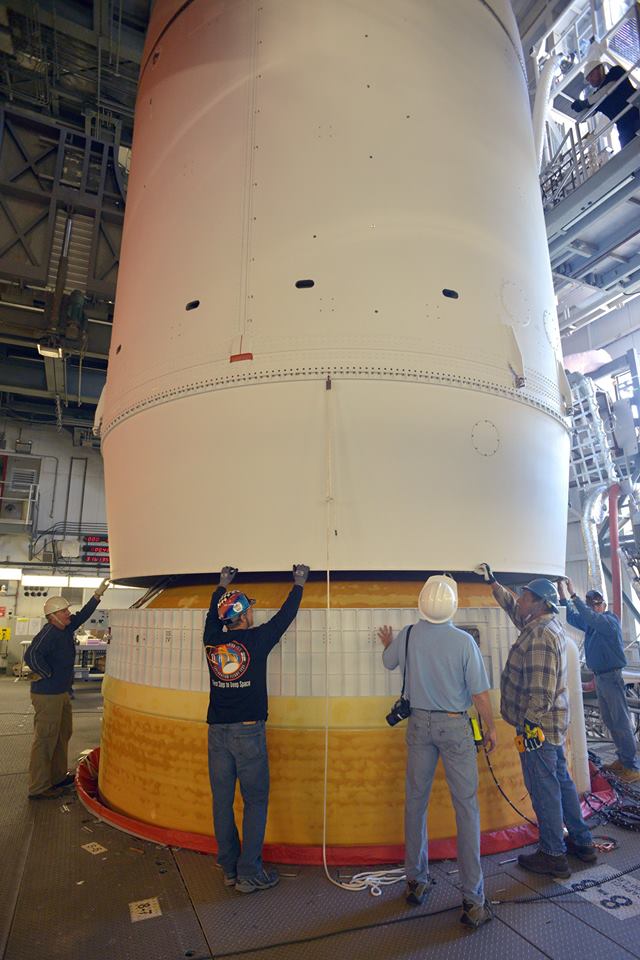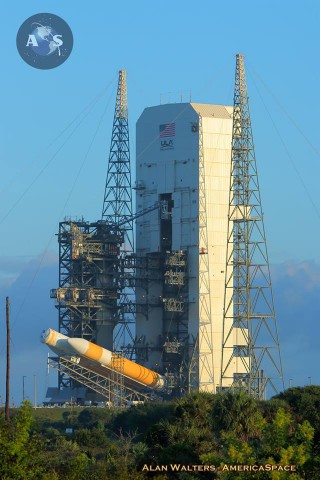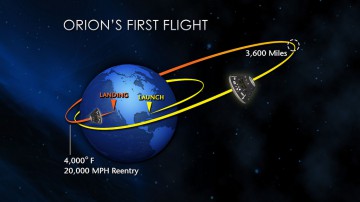
Despite the increasingly gloomy prospect of mostly cloudy skies over Cape Canaveral Air Force Station, with only a 60 percent probability of acceptable weather conditions, a 30 percent likelihood of rain, and a 10 percent chance of lightning, NASA and United Launch Alliance (ULA) stand ready to stage one of the most important missions for humanity’s future exploration ambitions Beyond Earth Orbit (BEO). Liftoff of the Delta IV Heavy—the largest and most powerful rocket currently in active operational service, anywhere in the world—is scheduled to occur from Space Launch Complex (SLC)-37B at the Cape, at 7:05 a.m. EST Thursday, 4 December. The “window” extends for two hours and 39 minutes, and, assuming a successful flight, the Heavy will boost the first Orion spacecraft to a peak apogee of 3,600 miles (5,800 km) above Earth. The Exploration Flight Test (EFT)-1 mission will thus mark the most distant voyage by a human-capable vehicle in more than four decades, since the end of the Apollo era.
Assuming an on-time launch, Orion will rise into orbit just five minutes after local sunrise, which will occur at 7:00 a.m. EST on both Thursday and the backup opportunity on Friday, thereby providing a spectacular sight for observers along the Space Coast. Yet AmericaSpace’s Launch Tracker, which will be covering tomorrow’s events as they happen, has cautioned that weather conditions are less than ideal. Quoting forecasts from Tuesday, 2 December, issued by the 45th Space Wing at Cape Canaveral Air Force Station, it is understood that the high-pressure front in the northeastern United States is causing gusty easterly winds and isolated coastal showers along Florida’s eastern seaboard, home to the Cape’s launch facilities. “This pattern will persist this week as the high-pressure area moves slowly east,” the 45th explained. “On the morning of launch, low-level clouds and showers are not expected to extend above the freezing level; therefore, the threat of lightning is very low. Still, coastal showers and gusty winds cause some concern for violating weather Launch Commit Criteria.” At the same time, there is a minimal risk from solar activity—with only a 5 percent chance that two active sunspot regions could pose threats from top-of-the-scale X-Class flares—and the key concerns appear to center around flying the Delta IV Heavy through rain and the potential impact of liftoff winds.

As described in AmericaSpace’s four-part Orion history series, the program to develop this next spacecraft to deliver humans beyond low-Earth orbit and eventually back to the Moon and onward to Mars has been fraught with frustration and difficulty, ever since its conception in President George W. Bush’s Vision for Space Exploration (VSE), unveiled in January 2004. Originally named the Crew Exploration Vehicle (CEV), the spacecraft was renamed “Orion” in August 2006, but both it and its umbrella “Constellation Program” met with political opposition and were terminated by President Barack Obama in 2010. However, development of Orion continued and in May 2011 it was “reborn” as the Multi-Purpose Crew Vehicle (MPCV). Six months later, the EFT-1 mission was baselined as a means of demonstrating the spacecraft’s capacity to endure the high radiation environment of the lower Van Allen Belts and survive a maximum re-entry velocity of more than 20,000 mph (32,000 km/h). This velocity is far higher than the 17,500 mph (28,800 km/h) experienced during shuttle re-entries and is markedly closer to the speeds that Orion would encounter during a return from lunar distance.
Preparations for this mission—which Jim Sponnick, ULA’s Vice President for Atlas and Delta Programs, proudly described as representing “the next step in U.S. crew space exploration beyond Earth orbit”—have taken place on numerous fronts over the past three years, most visibly in the final preparations of the EFT-1 Orion spacecraft at the Kennedy Space Center (KSC) and the processing of the Delta IV Heavy, which will be embarking on its eighth career mission since December 2004. The Heavy was most recently employed in August 2013 to deliver the NROL-65 classified payload into orbit on behalf of the National Reconnaissance Office and, until now, has been devoted almost exclusively to military customers. It is capable of delivering up to 63,470 pounds (28,790 kg) into a 125-mile (200-km) low-Earth orbit and up to 31,350 pounds (14,220 kg) into a 22,300-mile (35,900-km) geosynchronous transfer orbit and is thus ideally suited to loft the Orion spacecraft to its high apogee.
Final preparations for the EFT-1 mission entered high gear in the September-October timeframe, when Orion and its Launch Abort System (LAS) were mated and the Heavy was rolled from the Horizontal Integration Facility (HIF) to the SLC-37B pad surface. As detailed in AmericaSpace’s Photo Feature, the Orion/LAS stack was moved to the pad on 11/12 November, joining the booster which will provide its ride into space. A week later, engineers installed the spacecraft’s batteries, and on 19 November an all-up communications exercise—known as the “Live Sky Test”—was performed between Orion and the orbiting Tracking and Data Relay Satellite System (TDRSS). The next major milestone took place two days later, on the 21st, when managers from NASA and Orion’s prime contractor, Lockheed Martin, completed the Flight Readiness Review (FRR) and unanimously authorized a “Go” to proceed with an opening launch attempt on 4 December.

Since then, electrical systems checks were performed and flight controllers conducted a full mission dress rehearsal of their functions on Launch Day. Yesterday (Tuesday, 2 December), the Launch Readiness Review (LRR) saw ULA and Lockheed Martin declare themselves “Go” to press ahead with Thursday morning’s launch, notwithstanding the lingering weather issues. “The concern remains early morning precipitation at or near the Florida spaceport,” NASA explained, highlighting “an expected pattern that could see low clouds and sporadic showers move in from the Atlantic, later this week, possibly violating launch criteria designed to prevent the rocket from flying through precipitation.” Overall, there exists a 60 percent chance of acceptable weather on Thursday, although NASA has secured Eastern Range approval to support a launch on Friday or Saturday, if needed.
The EFT-1 mission is expected to last approximately 4.5 hours and will complete two orbits of Earth, during the second of which the Delta IV Heavy’s upper stage will boost Orion to its peak apogee of more than 3,600 miles (5,800 km). Fifteen times higher than the International Space Station (ISS), this will be the farthest a human-capable vehicle has reached since December 1972, and imagery from this altitude will show the Home Planet appearing to fill 60 percent of Orion’s windows. The spacecraft—which comprises a conical Crew Module and cylindrical Service Module, not entirely dissimilar in appearance to the Apollo Command and Service Module (CSM) combo—will remain affixed to the Heavy’s upper stage throughout the mission. Shortly before re-entry, the Crew Module will separate from the Service Module/upper stage “stack” and guide itself through the “sensible” atmosphere to a parachute-assisted splashdown in the Pacific Ocean, about 600 miles (965 km) off the coast of Baja California. It will then be recovered by teams from the USS Anchorage and USNS Salvor for inspection, refurbishment, and re-use on the Ascent Abort Test (AA-2) in 2019.
Current plans for Orion’s future in terms of actually carrying humans to BEO destinations remain very much in flux, with the maiden voyage of the mammoth Space Launch System (SLS) rocket not expected until the end of 2018. This will carry another Orion spacecraft—featuring a European-built Service Module—on the Exploration Mission (EM)-1, an unpiloted circumlunar flight, with the first crewed voyage (EM-2) not expected to take place before 2021. The latter is currently described as forming part of President Obama’s Asteroid Redirect Mission (ARM), sending two astronauts to rendezvous with and explore a captured asteroid in lunar orbit. However, with significant criticism having been expressed about the merits of such a venture, together with an overwhelming “Moon-First” attitude of NASA’s International Partners and with a new president due to occupy the White House in January 2017, the future of ARM remains questionable. More recently, it was reported by NASASpaceflight.com that its complexity makes it unlikely to be achievable before the mid-2020s.
Want to keep up-to-date with all things space? Be sure to “Like” AmericaSpace on Facebook and follow us on Twitter: @AmericaSpace
Missions » SLS » EFT-1 »



Paragraph 3, second last line, I think you want to say (14,220 kg), not (14,220 km). Sorry if I am being pedantic.
Ooops my mistake, paragraph 4. How embarrassing!
Oops, thanks for your sharp eyes, Simon. Error changed!